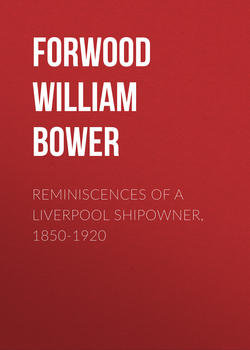Reminiscences of a Liverpool Shipowner, 1850-1920

Реклама. ООО «ЛитРес», ИНН: 7719571260.
Оглавление
Forwood William Bower. Reminiscences of a Liverpool Shipowner, 1850-1920
PREFACE
Chapter I. THE PASSING OF THE SAILING-SHIP
Chapter II. THE ERA OF THE STEAMSHIP
Chapter III. THE EVOLUTION OF THE MARINE ENGINE
Chapter IV. THE MAKERS OF OUR SHIPPING TRADE
Chapter V. OUR MERCHANT SHIPS AND THE WAR
Chapter VI. SHIPPING AND THE WAR
Chapter VII. THE “RED JACKET” A Reminiscence of 1857
Chapter VIII. THE “QUEEN OF THE AVON” A Reminiscence of 1858
Chapter IX. THE “GREAT EASTERN” A Reminiscence of 1861
Chapter X. BUILDING AN EAST INDIAMAN A Reminiscence of 1856
Chapter XI. OUR RIDDLE OF THE SANDS
Отрывок из книги
The old sailing-ship, with all the romance which surrounds it, must long linger in the affectionate regard of all British people as the creator of our great overseas trade and the builder-up of our commercial prosperity. The sailing-ship was the mistress of the seas for centuries. She founded our maritime supremacy, was the conveyor of the first fruits of our manufacturing industry to the ends of the world, and enabled us to train a race of sailors unequalled for their skill, courage, and patriotism, who in times of national peril have protected our homes and safeguarded the freedom of the world.
Liverpool owes her greatness as a city and her position as the first port in the world to her shipping. Possessing the only deep-water haven on the West Coast, she naturally became the port of shipment for the manufactures of Lancashire and Yorkshire directly our export trade began to develop. The beginnings of the shipping trade were small, for in 1751 there were only 220 vessels belonging to the port. The opening up of the American trade in 1756 gave a great impetus to shipping. It was destined, however, to receive a serious check by the world-wide war which started in 1756, and was waged almost continuously for sixty years.
.....
The treaty of peace between the United States of America and Great Britain, signed in 1814, marks the beginning of a new era in the history of shipping. The progress, however, for some years was slow; design and construction were hindered by our obsolete tonnage laws, which encouraged the building of a very undesirable type of ship. Meanwhile America was going ahead. Not only did she produce more ships, but they were well designed and equipped, and it was the general opinion that the American ship was superior to the British ship. When, in 1832, the monopoly of the East India Company came to an end, and the commerce of the Orient was thrown open to all British ships, there was at once an effort made to establish British shipping on a broader and more substantial basis. The opening of the China and East India trades gave rise to that competition which had been so long dormant, and without which there can be little incentive to improvement.
The American trade gave the first and great impetus to shipowning in Liverpool. The famous New York packets, the pioneer Black Ball Line, were established in 1816. This Line consisted at first of vessels of from 300 to 500 tons register. These little ships with their full bodies and bluff bows made wonderful passages, averaging 23 days outwards and 43 days homewards. They were for many years the only means of communication between this country and the United States. The “Dramatic” Line was started in 1836, with vessels of about 700 tons, and it is noteworthy that the “Sheridan,” of 895 tons, built the following year for this Line, was found to be too large for the Liverpool trade; but the trade rapidly grew and the packet ships gradually increased in tonnage. In 1846 the “New World” was built, of 1,400 tons. As a child I recollect being taken down to the dock to see this ship, as being the largest sailing-ship in the world; and many still living will remember the “Isaac Webb,” the “Albert Gallatin,” the “Guy Mannering,” and the “Dreadnought.” The ships of the “Black Ball” Line and the “Dramatic” Line were grand ships, and made many wonderful passages.
.....